Tempest’s Downpour – Big O VS Batman

Warning: the following contains spoilers for Big O and Batman: The Animated Series/Batman Beyond. But seriously, if you don’t already know everything there is to know about these shows, you deserve to be spoiled.
I’m celebrating April my way with Stuff That Isn’t Entirely Anime Month, kicking off with Big O versus Batman.
This comparison does not include any manga/comic format, and comprises Big O seasons 1 and 2 and Batman: The Animated Series in all its incarnations: Batman: The Animated Series, The Adventures of Batman and Robin, The New Adventures of Batman and Robin, Batman: Mask of the Phantasm, Batman: The Mystery of the Batwoman, as well as some references to Batman Beyond and Justice League for good measure. NOT The Batman or Batman: The Brave and The Bold.
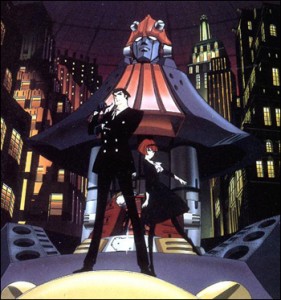
Roger Smith and Dorothy posing in front of the Big O
Big O is a giant robo series that, for a change, doesn’t star a young teenager. Instead, Roger Smith is a very capable 20-something-year-old (or possibly 60-something… or 40-something…) who is quite well-off financially enough to afford an estate and a butler. It features animation that favors dark colors and film-noir aspects I’ll touch more upon later. There are no big eyes, although the hair and eyebrows can get kind of freaky.
Batman: The Animated Series and its incarnations fought to keep the darker, edgier appeal of Batman that was resurrected by the Tim Burton films. Bruce Wayne is still a billionaire playboy by day, crimefighter by night, but all of it comes with some serious psychological twists. The program was applauded for printing on dark paper to avoid any unintentional lightness and dark/edgy themes.
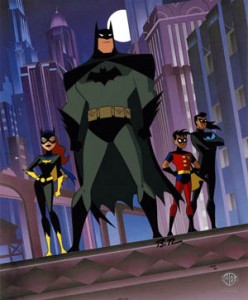
From left: Batgirl, Batman, Robin, Nightwing
Characters:
Sadly, I can’t go into detail on every character because that alone is a twelve-page research paper. Besides, someone else did all the work for me. However, I can give you some generalized comparisons.
Heroes:
Roger Smith is a super-rich playboy-wannabe who favors dark colors and a professional atmosphere, despite having a totally illegitimate day job. He pilots the giant robot, Big O, which seems to have its own conscience and thinks for itself. Roger keeps as company a gun-toting, robot-repairing butler named Norman and a wise-cracking, red-headed android named R. Dorothy Wayneright. Acting as foils are Dan Dustin, the commander of the military police who is equally grateful towards and resentful of the Big O, and Angel, a mysterious and alluring woman who lives by her own code and switches sides at the blink of an eye.
Batman plays the role of Bruce Wayne, a socialite and infamous playboy who keeps to himself and has mommy-and-daddy issues. The closest thing he has to family is a sarcastic butler who can treat wounds almost as well as a doctor, and a little boy in green tight….s…. Uhhh…. A little boy in green tights who grows into a man with a love of spandex, so Batman adopts another little boy to put in tights. Did I mention he’s a womanizer? In fact, he dates the red-headed Batgirl at some point, which is hinted in Batman: Mystery of the Batwoman and revealed in Batman Beyond. Commissioner Gordon, Batgirl’s dad, is the closest thing Batman has to a friend and Gordon literally turns in his badge more than once to aid Batman. Harvey Bullock acts as Gordon’s foil and constantly fights against him in regards to Batman, though he winds up helping Batman more than once.

Schwartzwald seems to resemble the Scarecrow in my opinion
Villians:
Roger Smith fights more than robots throughout his quest to keep Paradigm City safe. Alan (who winds up being a cyborg) is a serial killer who takes absolute giggle-inducing glee in ripping apart innocent people. Alex Rosewater is a privileged jerk with a god complex who doesn’t care how many people he mows down as long as he creates his perfect city. Schwartzwald is a former reporter who has gone psychotic with his search for the truth behind memories. Jason Beck starts off the series as a villain, but fails so hard that he winds up helping Roger several times — he’s also based off Lupin III. Gordon Rosewater is the founder of Paradigm City and just wants to be left alone to spout cryptic metaphors at his tomatoes, while Vera Ronstadt is… foreign.
Batman deals with every kind of villain in Gotham City from the psycho-crazy (Scarecrow) to the misunderstood-and-dangerous (Poison Ivy). Each of them seems to have a role in Bruce’s psychology, but none have such a grand effect as Joker. As much as he has a hot-and-cold relationship with Catwoman/Selena Kyle, and has the guilt of watching his best friend, Harvey Dent/Two Face, dissolve into insanity, nobody has an affect quite like the Joker. Why does Joker commit crimes? Because it’s funny to him. What is his obsession with Batman? Because Batman the most cryptic of easy targets. Joker’s entire life is devoted to picking at Batman’s personal wounds until he bleeds to death, and he has no stopping point: from seducing his own psychiatrist to kidnapping and brainwashing Batman’s sidekick, Joker will get what he wants.
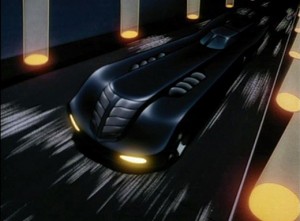
The freaking Batmobile, baby!
Gadgets and Gizmos:
Roger Smith’s watch may as well be known as “Plot Device.” Not only does he use it to summon Big O, it also includes a hidden compartment for piano wire to help slay enemies that just won’t stay down and has a visual two-way communicator built in. I wonder if it can tell time.
This isn’t unlike Batman’s utility belt, which holds every plot device necessary, though they did tone that down a bit in the Animated Series. He has Batarangs, the Batline/Line Launcher, Grappling Gun — heck, even a friggin’ underwater gas mask. (In one series of comics, Batman carries a piece of Kryptonite, Just In Case, and the Tower of Babel segment of the Justice League comic was devoted to Batman’s hidden files on How to Destroy The Justice League In Three Easy Steps.)
Of course, no suave, dark-haired superhero is complete without an awesome car. Roger Smith’s Griffon may as well be the Batmobile or James Bond’s Astin Martin with a few mods. These cars can do anything, end of story. But to top that, Batman’s ride gets an upgrade in the future and can levitate. Kickass.

The Big O
Plot:
On the surface, Big O is a giant robot series in a film noir/post-apocalyptic setting. Roger Smith is the most handsome man in the series, and government corruption is something the people face in every day life. Also robots: there’s a lot of them. The underlying plot is that the entire world, as the characters understand it, lost its memory 40 years ago and people are still trying to recover and pick up the pieces.
Batman is about an adult in his prime who spends his free time fighting crime and guilting himself over everything he ever did wrong. He runs by the justice system of Thou Shalt Not Kill, which never ends well for him, and has no super powers except quick wits and a pretty hefty computer. He trains a couple of kids to fight alongside him, and then more people crawl out of the woodwork to help him on a temporary- or permanent-basis.
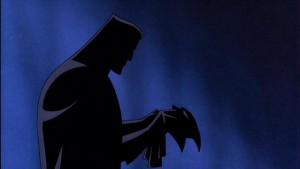
Bruce Wayne becomes Batman for the first time
Theme:
“Memories are very precious to people’s lives. They give us the opportunity to prove to ourselves that we exist! And if we lose them we have an unrelenting feeling of uncertainty.” — Roger Smith
Memories are what drove Schwartzwald mad. The lack of memories and the questions remaining are what keep Roger going through life. Roger claims that people are not defined by their memories and they have to keep moving forward, but in the final episode he gives the above speech in order to stop Angel from erasing everything. He succeeds (maybe?).
Batman is entirely defined by the memory of his parents’ deaths. Because of his survivor’s guilt, he puts his life on the line every day to prevent another 8-year-old from losing his parents.
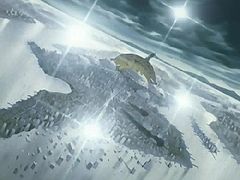
Paradigm City is meant to resemble Manhattan
Meanings in the Words:
The characters of Big O live in Paradigm City. The definition of “paradigm” is something that a model or pattern is based off of. Either it means humans tried to model it after a society that they had no basis of remembering, or perhaps all the world really is a stage, complete with skylights that Big O crashes into in the final episode. The fact that Roger’s command is “Big O, Showtime,” and the constant barrage of television screens as well as manuscripts in the final episode indicates that perhaps Paradigm is a twisted version of a reality show that takes place in New York City.
Gotham is a nickname for New York, even though the animated series creators claim the show takes place in New Jersey (of course). That doesn’t mean much until you take into account that New York City is an island in the Atlantic Ocean that has joint custody by New York and New Jersey (just try and argue it — I dare ya). Surrounded by water, with only a few bridges as a means of escape, the city can seem like a prison. The sheer number of people, the impossibly tall buildings, and smog-filled air give a sense of claustrophobia.
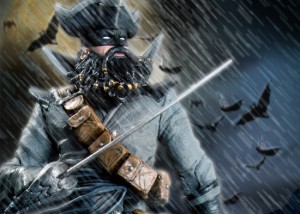
A Pirate!Batman action figure. I just wanted to show you because it’s amazing
Time period:
Does Big O take place in the future? The past? Is it the land inside our TVs, or does television mimic society? We may never get to know these answers as the series limbos through different styles and technologies.
Batman likes to think it takes place in the 1940’s with tommygun wielding gangsters and oldschool streetcars, but then there are computers, video games and women have real jobs. The animated series creators have explained that they wanted the series to feel like it takes place in its own time period separate from ours.
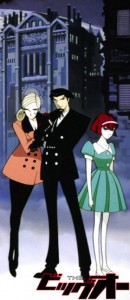
Left to right: Angel, Roger, Dorothy
Mindscrew:
So there’s television sets, right? Wait, no, back up. Gordon Rosewater wrote a book, but Angel actually wrote the book. Or did she rewrite history so she was the writer, when really Gordon was the writer? There’s a Roger Smith assembly line — why doesn’t every home have one? Maybe he isn’t a robot, but then why doesn’t he age? How does he know how to pilot Big O and WHAT HAPPENED 40 YEARS AGO? That’s only SOME of the questions you’ll be scratching your head over by the end of the series. It’s like trying to decipher Lain or Evangelion.
Let’s compare this to the ending of Batman, where another person takes up the mantle as Batman but is a half-Batman clone that was secretly created without the parents’, or Bruce’s, knowledge, who displayed no immediate abilities and had to rely mostly on a suit to do the work for the first season or two. Yeah. Lots of sense.
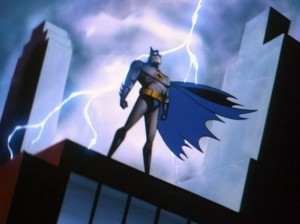
A picture from the opening credits
Animation:
Big O started off looking like it was animated 20 years ago. It didn’t have much of a budget and the animation style was simple. It utilized dark colors and borrowed techniques from film noir, while shying away from typical anime styles like big, expressive eyes. Cartoon Network funded season 2, providing a very noticeable animation bump where the animation became more streamlined and the characters looked different, despite receiving no design changes.
Batman: The Animated Series created its own animation style on dark paper that was far from streamlined. The characters looked older and showed a variety of expressions. Before the third season, the characters all received makeovers. This was met with mixed reviews: some people looked scarier or more fascinating like the Scarecrow and Poison Ivy, while some new looks just didn’t work, like the Joker. Ironically, the new look made Bruce look much younger, while in Batman Beyond he aged rather ungracefully.
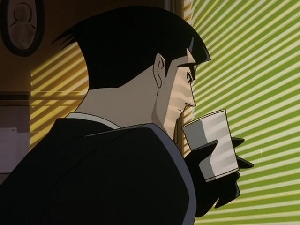
The light from the blinds casts a shadow over Roger’s face — a popular film noir technique
Mixed Heritage:
While Big O borrows heavily from American cartoons and Film Noir, Batman adapted more techniques from anime. Terry!Batman in Batman Beyond even has a mecha.

Dorothy at the piano
Music:
Big O relies on melodramatic saxophone melodies and simplistic music reminiscent to the 1940’s. Every time a character walks into a bar, the music gives the feeling of some old American film. Two recurring characters play the piano, and do so with some regularity. Then, bizarrely, the theme song takes on heavy Queen influences with a full operatic chorus singing the name of our hero, and a good dose of Engrish with “we have came today.” As sirens play out in the background and a heavy bass beat leads the song, you can tell that this series means Serious Business.
Batman takes the fully-orchestrated Elfman theme song from the Burton film and recreates it with a half-sized orchestra, but it doesn’t lose the feel. The song crescendos and decrescendos depending on the intensity of the animation playing around it. The music throughout the series mimics other music from the films.
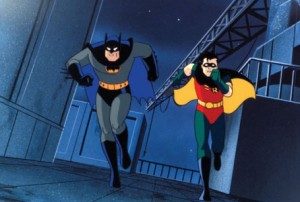
Batman and Robin running
Production Problems:
Both shows were meant to be given another season. In Big O’s case, Cartoon Network found it more profitable to fund cheap comedy programs. The director still wants to finish the story.
The New Adventures of Batman and Robin was offered another season, but Paul Dini (writer) and Bruce Timm (director) had to turn it down because they were burnt out. They went on to write/direct Justice League and Batman Beyond, and Dini went on to write Batman: Arkham Asylum.

Roger Smith summons Big O using his watch
Despite its length, this article only touches the surface of Big O and Batman. If you want to do your own research at home, feel free to follow the links below. Remember to buy the DVDs, and Wikipedia is your friend:
http://tvtropes.org/pmwiki/pmwiki.php/Main/TheBigO
http://tvtropes.org/pmwiki/pmwiki.php/Characters/TheBigO
http://tvtropes.org/pmwiki/pmwiki.php/Main/BatmanTheAnimatedSeries
http://tvtropes.org/pmwiki/pmwiki.php/Main/HumongousMecha



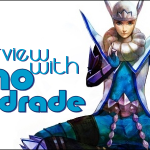

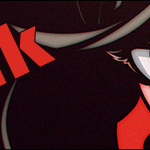
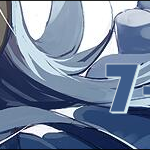









He doesn’t even have super powers…
Neither does your mom, but that doesn’t stop me.
HOLY KARP! A Pirate Batman…O_O
I have Run Down set on loop as the morning alarm on my computer.
Big O! has R. Dorothy Wainwright, while no Batman show does. Therefore, Big O! wins. End of story.
Everyone knows Batman is superior 😛
Pirate Batman… -facepalms-
Liked your summation, dude, re Big O. Loved R Dorothy when the series aired on CN aka Turner Broadcasting but found Roger more insecure than Bruce when it came to conflict resolution. Real estate investment would be a bad deal in Big O unless motive was to flatten Paradigm City to make way for the never built Intergalactic Freeway of Hitchhiker’s Guide to the Galaxy fame.
As for Pirate Batman: looks like Johnny Depp from Pirates of the Carribean?
Batman > Captain Jack Sparrow, but only by a little.
As for somehow creating a reasonable argument that involves Hitchhiker’s Guide mixed into anime, you get all my love for the day. Do with it as you please.